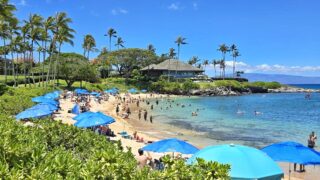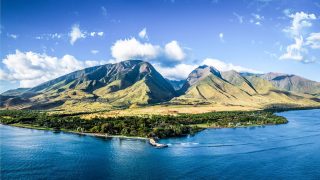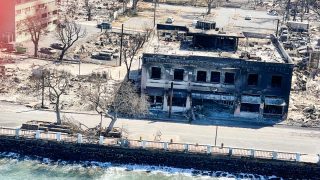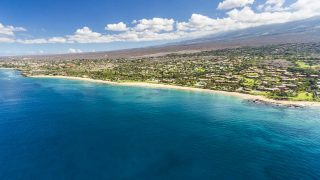Scientists are preparing for one of the next challenges on Maui following the Lahaina fire. Recent reports suggest that not only has the water system been compromised in Lahaina, but that “the sheer scale of the damage could pose unprecedented threats to Maui’s diverse coastal ecosystem.”
The deadly Lahaina fire created a toxic environment that will likely affect water quality. Nature Journal reported scientists “fear that contaminated runoff (at Lahaina) will flow onto the island’s sensitive coral reefs.”
Concern moves to long-term impact on the ocean, Maui coral reefs, and fish.
Maui’s reefs are essential to coastal life on the island, as well as tourism and the island’s economic well-being. The US Environmental Protection Agency (EPA) has been involved in preventing ocean contamination. They are spraying a soil stabilizer to create a crust on the ashes, a process which is relatively new to fire contamination prevention and cleanup. The application of Soiltac will be done in concert with Maui County to help control dust from the fire.
Testing at Lahaina is to begin.
Ash testing is just beginning at Lahaina, following testing done at Kula, the site of upcountry fires. At Kula, extremely high arsenic levels have already been detected, together with lead and cobalt. That was announced on October 15 by the Hawaii Department of Health.
Ash samples will be collected next at Lahaina, but the results are expected to be similar to those found at Kula, where the arsenic level, for example, was 140 times greater than the “action level.” OSHA says that “Action level means a concentration of inorganic arsenic of 5 micrograms per cubic meter of air (5 µg/m3) averaged over any eight (8) hour period.”
UH Manoa scientists lead in Lahaina fire recovery and research.
The university said that the Lahaina fire “is a different beast. There’s no playbook for this. Everybody is just figuring it out as we go.” UH scientists have been leading in testing for contaminants.
UH has been assessing the levels of benzene, formaldehyde, and nearly 100 other dangerous chemicals and contaminants. UH will ultimately test hundreds to thousands of water samples taken from around Maui.
Other wildfires spawn concerns following the Lahaina fire.
The potential issues that all the scientists are focused on include algae blooms, acidification, and changes in water chemistry and nutrients. Previously, very widespread algae bloom occurred near Australia following wildfires. More research is needed to determine the link between wildfires, pyrogenic aerosols, and marine photosynthesis.
“All kinds of particulate matter as well as gases and ash are blown off from wildfires.” That according to Quest University Canada marine biologists. These add nutrients to the ocean, including nitrogen and phosphorus. With this over-fertilization, algae grows, consuming oxygen. That can be detrimental to fish.
The University of Hawaii plans to use the National Science Foundation and FEMA grants in its work on Maui. One study will be related to analyzing fish populations off Maui for contamination to ensure they remain safe for human consumption.







My favorite beach is “Black Rock Beach” both in the Caribbean and Pacific, so when we saw the fires last year it was terrible to watch. Our hearts go out to all of those that were affected by this terrible event.
Apparently October 3rd we will be in Lahaina on the Crown Princess. We have sailed into this area four times and each time we have enjoyed visiting the Whalers Village and Black Rock Beach. In the past we have taken a local bus up to Whalers Village and then walked over to Black Rock Beach. Will this be a memory or will this be an opportunity in October.
Our prayers go out to the residents and the people who are involved in restoring the area to its beautiful state.
Living in Kaanapali/Lahaina area I can attest the water looks good -we are technically West of Lahaina town; Kaanapali Beach, Black Rock area/North Kaanapali Beach. The Monk Seals, Manta Rays and fish have moved up here and local long-distance swimmers say they are seeing More Fish now ! The currents flow South towards Kehei, away from Lahaina town …not sure of their water condition & abundance of fish…many Locals are still fishing off the coast in Kaanapali and eating their catches. It would be good to know if the water is truly safe (“they” say it is) and how testing and results will be made known…ps Lahaina town public drinking water is No Good! Ours is Private Water which is good so “they” say…
Hi Nita.
Thanks for your on-the-ground reporting again!
Aloha.
I also live North of Lahaina and swim/snorkel in the ocean almost every day and found that there is more and bigger fish than before, so I guess they did move North! As much as Maui needs the rain (and I do hope we get some soon), it might have helped not having rain before they applied the coating to prevent ashes and everything else from the fires end up in the ocean. Hoping for the best …
Currents change based on wind. You can see a current forecast on Pacioos (pacioos.hawaii.edu/currents/model-hawaii/). The currents don’t typically go south.. the currents right in front of Lahaina town normally go towards Lana’i. That’s why Lana’i has received so much debris from Lahaina.
On KITV EPA Commander Tom Dunkelman said the EV and power walls are very dangerous and special treatment like a bomb squad is needed after the fire. Add that into your EV and solar risk benefit .
As reported by Civil Beat, Maui plans to ship the toxic waste to the mainland.
How hypocritical to keep Hawaii pristine by sending others your toxic waste.
Speaking as a California native, still living here, with family on Maui, there are numerous places where that toxic waste can be disposed. Abandoned mines in the desert are one good start. Keep in mind that the lead left from paint was once in the ground somewhere. Arsenic is a naturally occurring metal that is fairly high in volcanic regions. I say, bring the toxic waste here and dispose of it in the old mines, some underground, others are still open pit. Yes, you cover the open pit disposal with fresh rock and soil.
Assuming the toxic waste will not be spilled while in transit by ocean vessels and trains or trucks to its final destination. Why do environmentalists think sending their pollution to other states is a magic solution?
Rob T, I think that given the Tiny size of Maui compared to huge expanses of desert or other non-inhabit areas on the mainland is a perfect solution. I do not Want more pollution in California, but I know there are so many areas where the toxic waste from this fire could be placed, covered and not be a threat to anyone, that I am willing to say, bring it on. I am sure there are other areas too.
This is main reason I have postponed my trip to Maui. I am a water gal, and also do not want to breathe this stuff and years down the road, be told I have issues from the toxins. Things like this creep up, they dont happen on one day. Maui has tropical winds, and those winds blow everywhere, just like the Canadian Smoke blew all the way to Florida. I hope they can do something to help the already sensitive eco system.
I don’t know, if there is special fare to visit Maui, HI?
Hawaii wants and needs tourists to recover from the fire in lahaina.
Lahaina is only 15%
Of Maui and those who were displaced are well taken care of by Red Cross and FEMA.
What we need next is work for the displaced so that we can help them to get crack up on their feet , instead of feeling helpless and going into depression
Last night we spoke to our son & daughter-in-law who live in Napili. One of their church acquaintances runs a heavy equipment excavation company. His home was destroyed, but family safe. That man has worked nearly every day since Aug. 9th for the county/state/FEMA, whoever, providing heavy equipment while his family is housed in one of the hotels. He found out late last week he must vacate by the end of the month. Where does he go? Adequate housing for those who truly need it must be found.